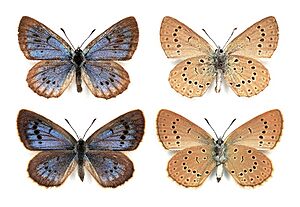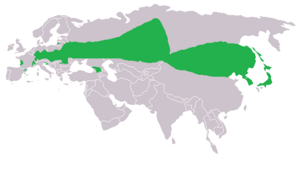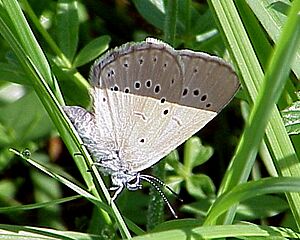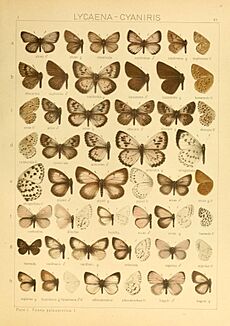Scarce large blue facts for kids
The scarce large blue (Phengaris teleius) is a beautiful type of butterfly. It belongs to the Lycaenidae family, which includes many small, colorful butterflies. You can find this butterfly in many parts of Europe and Asia, including countries like Austria, France, Germany, Hungary, Italy, Poland, Russia, and all the way to Japan. Scientists first officially described this butterfly in 1779.
Quick facts for kids Scarce large blue |
|
|---|---|
 |
|
| Conservation status | |
| Scientific classification | |
 |
|
| Distribution map | |
| Synonyms | |
|
Contents
Life Cycle of the Scarce Large Blue
The scarce large blue butterfly has a very interesting life cycle. It starts as a tiny egg.
Early Life: Plant Feeder
When the larva (caterpillar) first hatches, it eats a specific plant called Sanguisorba officinalis, also known as great burnet. The caterpillars bore into the plant's flower heads and feed on the seeds inside.
Later Life: Ant Nest Dweller
After a while, something amazing happens. The caterpillar leaves the plant and moves into an ant nest! It pretends to be an ant larva, and the ants take care of it. But here's the twist: the caterpillar actually eats the ant larvae. This makes it a predator inside the ant nest.
Two common types of ants that host these caterpillars are Myrmica rubra and Myrmica scabrinodis. Scientists have found that keeping meadows grazed by animals helps these butterflies survive. Grazing helps maintain the right conditions for the great burnet plant and the host ants.
Appearance of the Butterfly
The scarce large blue butterfly has distinct features.
Male and Female Differences
Male butterflies are mostly blue on their upper side, but not shiny. They have black edges and some black spots on their wings. Female butterflies are much darker, often with more black on their wings, though they might have lighter areas with rows of black spots.
Underside Markings
The underside of their wings has many small, round spots called ocelli. These spots are like little eyes. One way to tell the scarce large blue apart from a similar butterfly, the arion, is by looking at these spots. The scarce large blue does not have an ocellus (eye-spot) in a specific part of its forewing cell.
Where They Live and Fly
These butterflies are found in damp meadows where the great burnet plant grows. They often fly slowly and settle on this plant with their wings closed. They are usually seen flying in July and August.
Types of Scarce Large Blue Butterflies
There are several different types, or subspecies, of the scarce large blue butterfly. These subspecies often look slightly different or live in different parts of the world.
- P. t. teleius: Found in central Europe, the Caucasus region, and western Siberia.
- P. t. chosensis: Found in southern Ussuri.
- P. t. euphemia: Found in Amur Oblast and Ussuri.
- P. t. obscurata: Found in Transbaikalia.
- P. t. sinalcon: Found in northern China.
- P. t. splendens: Found in the Altai mountains and Sayan Mountains.
Images for kids






